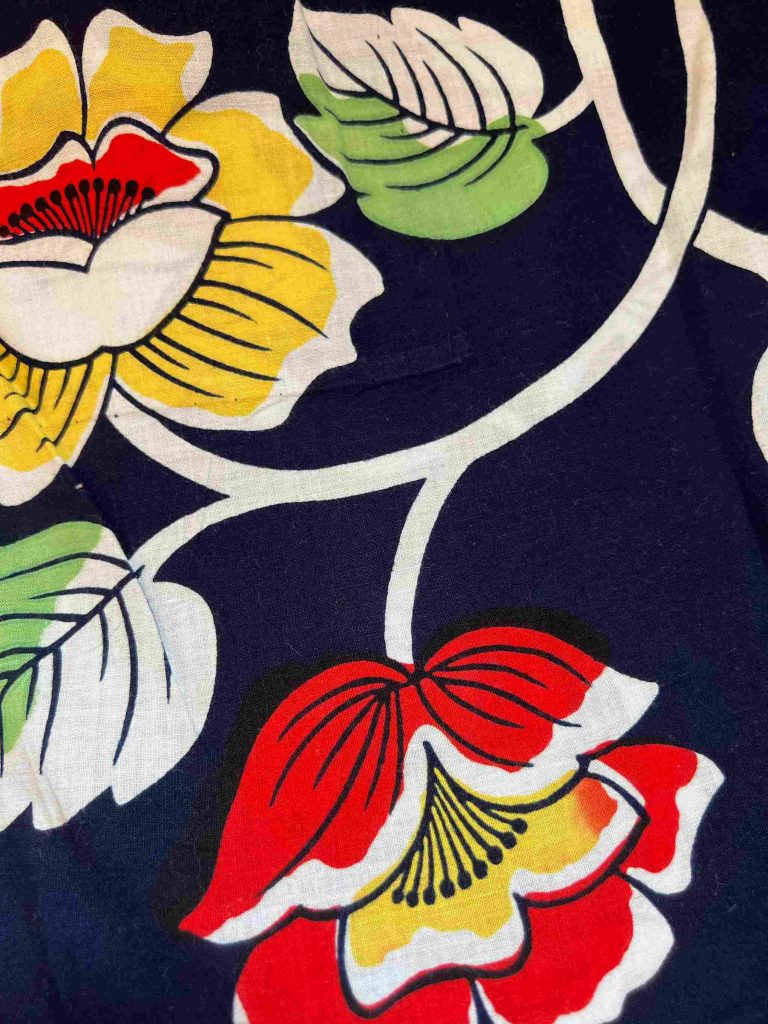
A Ukrainian woman writes down her wish in Ukrainian on a thin strip of paper and ties it to a bamboo branch at the Ukraine Exchange Center in Shibuya, Tokyo on July 7 (photo by Kenji Suzuki.)
The yukata is the most humble type of kimono. It probably has its origin in the Middle Ages (400s-1400s), as a linen garment worn in a steam bath. During the Edo period (1603-1868) cotton was produced domestically. By the 1800s the price had come down dramatically and cotton was used for everyday wear for working people.
Cotton kasuri and striped kimono, along with indigo-dyed pants and jackets were worn all over Japan. With the rise of sento (public baths) in Edo, it became fashionable to be seen going to and from the bath in a beautifully stencil-dyed indigo and white yukata.
Over the years the dyeing methods have changed. These days, digital print rather than stencil dyeing is the most common way of decorating yukata. However, other methods of decoration still remain, such as chusen zome and shibori, or tie-dyeing.
For the last three years, the Japanese summer has been hot as we lived with COVID-19. But it hasn’t felt like a Japanese summer. That's because summer is marked by a series of festivals, and yukata are ubiquitous at festivals. Without these events, many of which have deep historical origins, the long hot days stretch without a sense of the passing of time.


A Return to Festival Fun: Rumi Rock
This year the festivals are finally back and everyone is ready to celebrate. Of course, without the festivals, no one was shopping for yukata, so it was a tough time for the industry too. But now the customers are back, so I went to Rumi Rock store and asked what designs were particularly popular this year.
Their new Alice in Wonderland design is selling well, I learned. But designs from the Edo period seem to be particularly popular this year. There are yukata with warriors on horseback in front of Mount Fuji. And there are others with designs of plum blossoms and Japanese hairstyles.


Rumi Rock is also selling a new easy-to-tie obi, wrapped and held with a buckle, in sparkling colors. I noticed Edo style patterns in other shops too. So Rumi those designs appear to be trending this year.
Now the big question: where will you go in your yukata? There are many choices.


A Special Time for Yukata Wearing: Tanabata
The summer gets off to a romantic start with Tanabata, the star festival on July 7. It is the one day of the year when the herd boy can meet the spinning or weaving maiden, according to Japanese legend.
In many places you can see tall bamboo branches with colored strips of paper tied on. They bear the wishes of the writer and are often open to the public to write their own message.
One famous Tanabata display is in Sendai, Miyagi Prefecture. There is also a famous summer festival in Ebina, Kanagawa Prefecture. Everyone hopes for a clear and starry night, so that the lovers can meet across the milky way.
Around this time look out for morning glory (the flower) festivals as they are popular during Tanabata.


Just the Start of Festival Season
Aomori is famous for its huge floats at Nebuta matsuri, and Akita is famous for its lanterns at the Kanto matsuri. Kyoto's gorgeous parade at Gion matsuri is famous worldwide. And Tokushima is famous for Awa Odori dancing festival in August.
There are also many smaller but fun festivals in and around the Tokyo area, and all over Japan.
At Kawasaki Daishi there is a wind chime festival with wind chimes from all over Japan for sale. It is scheduled from July 17 to 23.


One of my favorite summer activities is bon odori. People get in a circle and dance around a yagura, a kind of scaffold with a platform on it, to the sound of beating drums and music.
These bon odori festivals happen everywhere and anyone can join in. Ebisu, a town in Shibuya, Tokyo, will hold bon odori on July 27 and 28. And Shinjuku’s Eisa festival, with Okinawan style dance will be on July 30th.
Tsukiji Honganji also holds bon odori, but is limiting the numbers this year. Koenji celebrates with Awa Odori at the end of August. For those who don’t dance, there are stalls with street food, games for children and just chances to be outside enjoying summer street life.


Riverbanks and Fireworks Festivals
For those for whom the crowded festivals are too much, you can take a picnic mat and a fan, and sit on a river bank to watch fireworks.
The Sumida River fireworks will be held on July 29, but there are many fireworks displays throughout the summer.
Yukata are de rigueur at fireworks festivals and you may feel a little under-dressed if you go without one. So, get out your yukata and obi. Where will you go first?
RELATED
- Make A Wish - It's Tanabata!
- [Kimono Style] Yukata: Simple Summer Beauty
- Spectacular Fireworks Festival in Zushi: Japan's Special Summer Tradition
Author: Sheila Cliffe
Read other articles by the author on kimono and Japanese culture in her column [Kimono Style] on JAPAN Forward.








